Sales is a data-driven game. From tracking leads and revenue to understanding team performance, managing data efficiently can transform how you work. Tools like VLOOKUP in sales streamline data management, enabling individual contributors, team leaders, and managers to gain actionable insights.
This blog dives into practical applications of VLOOKUP, helping sales professionals create dynamic Excel sheets tailored to their roles. With additional tips on Google Sheets’ IMPORTRANGE function and data cleaning practices, you’ll learn how to elevate your sales game with better tools and smarter systems.
How Individual Contributors Can Use VLOOKUP in Sales
The Master Page: Your Sales Dashboard
Your Master Page is the heart of your data. Here’s what it should include:
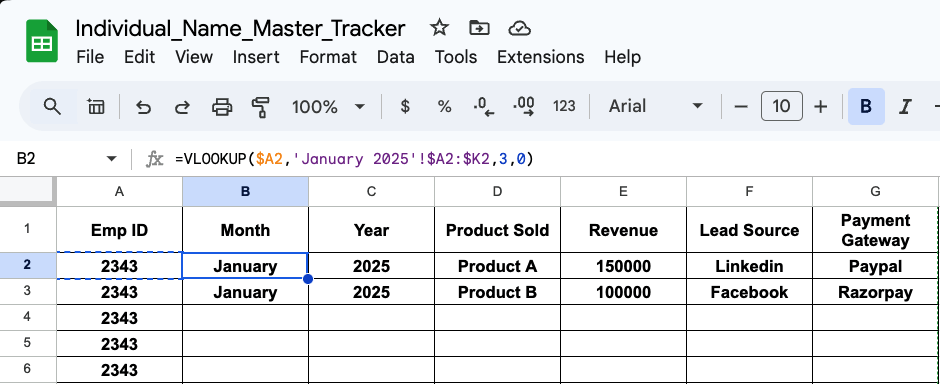
- Emp ID: Unique identifier for accuracy.
- Month & Year: For time-based tracking.
- Product Sold: Items or services sold.
- Revenue: Sale Amount
- Lead Source: Where leads originated (e.g., LinkedIn, referral).
- Payment Gateway: Platform used for payment.
Monthly Sheets: Tracking Daily Sales Data
Each month deserves its own dedicated sheet. Use columns like:

- Emp ID: Unique identifier for accuracy (first column for easier VLOOKUP).
- Date, Month, Year: The transaction timeline.
- Customer Details: Name, email, and phone number.
- Product Sold: Items or services sold.
- Revenue Generated: Sales value for each transaction.
- Lead Source: Origin of the lead.
- Payment Gateway: Platform used for payment.
VLOOKUP Formula Example for Individual Contributors
To pull total revenue for January 2025 from the “January 2025” sheet into the Master Page:
=VLOOKUP($A2,'January 2025'!$A2:$L2,3,0)Here’s how this formula works:
- $A2: Refers to the unique Emp ID in the Master Sheet. The dollar sign ($) locks the column (A) to ensure it doesn’t change when the formula is dragged across rows.
- January 2025′!$A2:$L2: Specifies the range in the “January 2025” sheet from which data will be pulled. The dollar sign ($) locks the starting column (A) and row (2) in the range to maintain consistency when the formula is copied.
- 3: Indicates the column number (relative to the range) to retrieve data from—in this case, “Month”.
- 0: Ensures an exact match for the Emp ID.
This formula consolidates monthly data into a single dashboard, providing clarity on performance trends.
Why Uniform Data Matters
Using consistent product names, payment gateway labels, and lead source inputs eliminates data cleaning hassles. For example:
- Use “PayPal” instead of variations like “paypal” or “Pay Pal.”
- Ensure names like “Product A” are used uniformly across all sheets.
Maintaining clean data minimizes errors when using VLOOKUP in sales, ensuring accurate insights every time.
Here is the link to the template which you can make a copy and edit to start your own journey: click here
How Team Leaders Can Use VLOOKUP in Sales
The Master Page: Your Team Dashboard
For team leaders, your Master Page is the control center for tracking individual contributions. Here’s what it could include:
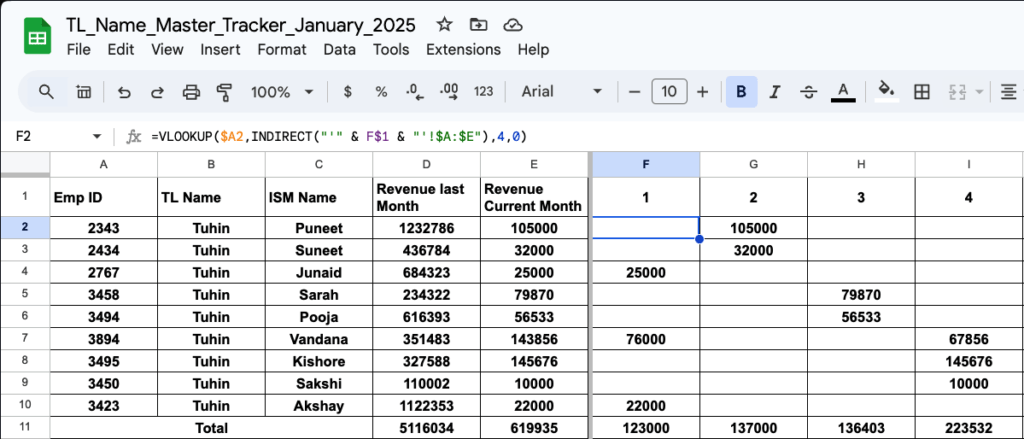
- Emp ID: A unique identifier for each team member.
- TL Name: Your name to identify team-level data.
- ISM Name: Inside Sales Manager’s name to track performance at the individual level.
- Revenue Done Last Month: To analyze month-over-month progress.
- Revenue Current Month: Tracks ongoing performance.
- Daily Revenue Columns: Consolidates daily figures for detailed insights.
Daily Sheets: Monitoring Daily Performance
Each day of the month should have its dedicated sheet. Columns to include:
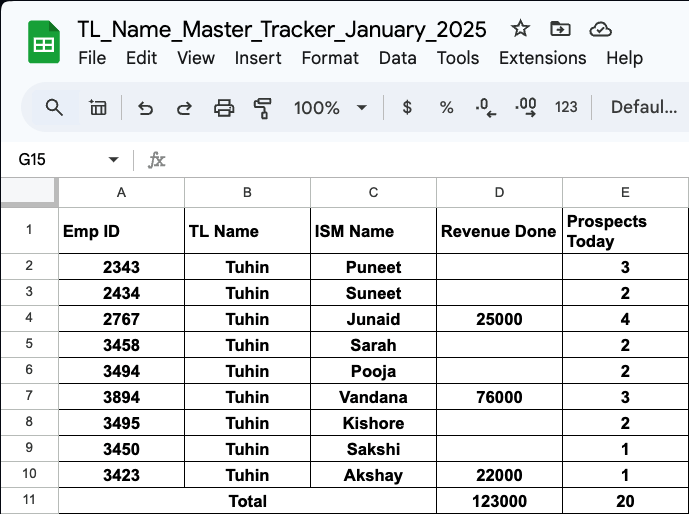
- Emp ID: Unique identifier for accuracy (first column for easier VLOOKUP).
- TL Name: Your name to keep track of your team’s contributions.
- ISM Name: Inside Sales Manager’s name to track performance at the individual level.
- Revenue Done Today: Sales generated by the employee on that specific day.
- Prospects Handled: Number of leads or prospects managed during the day.
Dynamic VLOOKUP Example
To link daily sheets dynamically to the Master Sheet:
=VLOOKUP($A2,INDIRECT("'" & F$1 & "'!$A:$E"),4,0)Here’s how this formula works:
- $A2: Refers to the unique Emp ID in the Master Sheet. The dollar sign ($) locks the column (A) to ensure it doesn’t change when the formula is dragged across rows.
- INDIRECT(“‘” & F$1 & “‘!$A:$E”): Dynamically references the range in the sheet named in cell F1 (e.g., “1”). The INDIRECT function constructs the range reference.
- 4: Specifies the column number for “Revenue Done Today” in the range to extract data.
- 0: Ensures an exact match for the Emp ID.
The dollar sign ($) in F$1 locks the row (1) of the cell reference while allowing the column (F) to adjust when the formula is copied horizontally. This ensures flexibility when referencing different daily sheets.
This approach ensures a detailed breakdown of each team member’s daily performance, helping you identify trends and address gaps effectively.
Here is the link to the template which you can make a copy and edit to start your own journey: click here
Manager-Level Insights Using VLOOKUP in Sales and IMPORTRANGE
Connecting TL Sheets Using IMPORTRANGE
As a manager overseeing multiple teams, integrating TL sheets into one Master Manager Sheet is crucial. Google Sheets’ IMPORTRANGE function simplifies this.
Example:
Import data from a TL’s sheet to your Master Sheet:
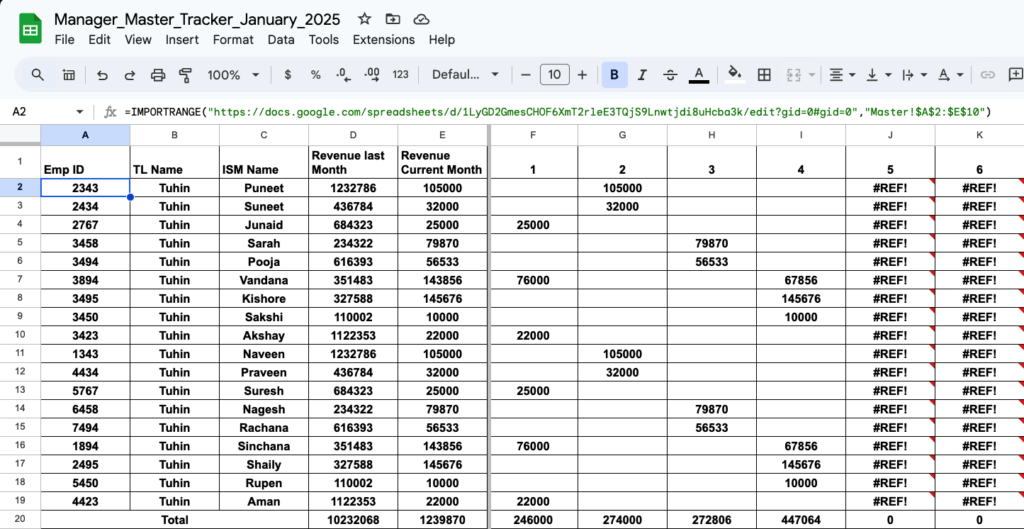
- Emp ID: A unique identifier for each team member.
- TL Name: Your name to identify team-level data.
- ISM Name: Inside Sales Manager’s name to track performance at the individual level.
- Revenue Done Last Month: To analyze month-over-month progress.
- Revenue Current Month: Tracks ongoing performance.
- Daily Revenue Columns: Consolidates daily figures for detailed insights.
Consolidating Data Across Teams
To merge data from multiple TL sheets:
- Use IMPORTRANGE for each TL sheet.
- Combine imported data into a single sheet.
=IMPORTRANGE("https://docs.google.com/spreadsheets/d/1LyGD2GmesCHOF6XmT2rleE3TQjS9Lnwtjdi8uHcba3k/edit?gid=0#gid=0","Master!$A$2:$E$10")Replace “TL_Sheet_URL” with the actual URL of the TL’s Google Sheet and specify the range.
IMPORTRANGE: This is the function name used to import data from another Google Sheet.- First Argument –
"https://docs.google.com/spreadsheets/d/1LyGD2GmesCHOF6XmT2rleE3TQjS9Lnwtjdi8uHcba3k/edit?gid=0#gid=0":- This is the URL of the Google Sheet you want to import data from.
- Ensure the sheet is shared with the user or account that is using the formula. Otherwise, you’ll get a “#REF!” error.
- Second Argument –
"Master!$A$2:$E$10":Master!: Refers to the name of the specific sheet (or tab) in the source spreadsheet you want to pull data from.$A$2:$E$10: Specifies the range of cells you wish to import. The use of absolute references (indicated by$) ensures the cell references do not change when copied or dragged across the manager sheet.- Column A to E: These are the columns being imported.
- Row 2 to Row 10: These are the specific rows within the range. Adjust as needed.
- Output:
- Once the function is executed, the data from the specified range in the source sheet will appear in the destination sheet.
Daily Sheets: Monitoring Daily Performance
Each day of the month should have its dedicated sheet. Columns to include:
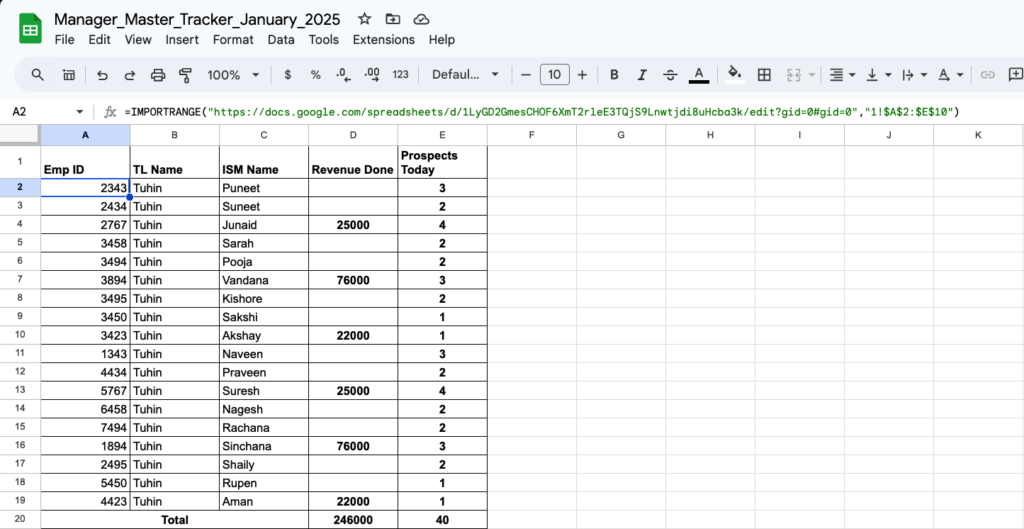
- Emp ID: Unique identifier for accuracy (first column for easier VLOOKUP).
- TL Name: Your name to keep track of your team’s contributions.
- ISM Name: Inside Sales Manager’s name to track performance at the individual level.
- Revenue Done Today: Sales generated by the employee on that specific day.
- Prospects Handled: Number of leads or prospects managed during the day.
=IMPORTRANGE("https://docs.google.com/spreadsheets/d/1LyGD2GmesCHOF6XmT2rleE3TQjS9Lnwtjdi8uHcba3k/edit?gid=0#gid=0","1!$A$2:$E$10")Replace “TL_Sheet_URL” with the actual URL of the TL’s Google Sheet and specify the range.
Breakdown:
IMPORTRANGE: Function to import data from another Google Sheet into the current sheet.- First Argument –
"https://docs.google.com/spreadsheets/d/1LyGD2GmesCHOF6XmT2rleE3TQjS9Lnwtjdi8uHcba3k/edit?gid=0#gid=0":- URL of the Google Sheet where the data resides.
- The source sheet must be shared with the destination sheet for access permissions.
- Second Argument –
"1!$A$2:$E$10":1!: Refers to the specific sheet/tab named “1” in the source file.$A$2:$E$10: Defines the exact range of cells to import:- Columns A to E: Specifies the range of columns to import.
- Rows 2 to 10: Specifies the range of rows to import.
$Symbols: Lock the range for absolute reference, ensuring it doesn’t shift when the formula is copied or dragged.
- Output:
- Pulls all the data from the specified range (
$A$2:$E$10) in the sheet named “1” and displays it in the current Google Sheet.
- Pulls all the data from the specified range (
Key Features:
- Dynamic Updates: Reflects changes from the source sheet in real time.
- Sheet Reference: Explicitly points to the tab “1” in the source file for accuracy.
- Absolute References: Prevents unintentional shifts in the range when copying the formula.
- Versatility: Can consolidate data from multiple sheets or files seamlessly.
Things to Keep in Mind:
- Access Permissions: Ensure the destination sheet has permission to access the source file.
- Consistent Naming: Sheet names like “1” must match exactly, including case sensitivity.
- Error Handling: If the sheet name or range doesn’t exist, it will return
#REF!or#VALUE!errors.
This formula is ideal for merging and analyzing data from multiple sources efficiently.
Here is the link to the template which you can make a copy and edit to start your own journey: click here
The Role of Consistency and Automation
Why Consistent Data Inputs Matter
Consistent inputs reduce errors and simplify the use of VLOOKUP. Train your team to follow naming conventions for:
- Product Names
- Lead Sources
- Manager and TL Names
Conclusion: VLOOKUP in Sales Data for Smarter Decisions
Mastering VLOOKUP and IMPORTRANGE can revolutionize the way you manage sales data. By using structured templates for Individual Contributors, Team Leaders, and Managers, you can significantly reduce manual work while ensuring accuracy and efficiency.
For Managers and TLs, daily updates are critical. Automating processes where possible and consistently updating the IMPORTRANGE formula for the correct data sources can make your sheets a powerful tool for actionable insights. These practices allow you to spend less time managing data and more time making decisions that drive growth.
Stay Connected
Looking for personalized advice to adapt these templates to your business? I’d love to help! Reach out to me via my contact form, and let’s explore how you can optimize your sales processes.
Stay in the loop for more actionable insights by following me on LinkedIn. My goal is to empower sales professionals like you with strategies that lead to measurable results—don’t miss out!
Response
-
This writing has the rare gift of making complex ideas feel both accessible and profoundly meaningful.







Leave a Reply